Geology, Petrology and Geochronology of the Late Cretaceous Klaza Epithermal Deposit: A Window into the Petrogenesis of an Emerging Porphyry Belt in the Dawson Range, Yukon, Canada
Abstract
1. Introduction
2. Regional Geology and Mineralizing Events
2.1. The Mount Nansen Gold Corridor (MNGC)
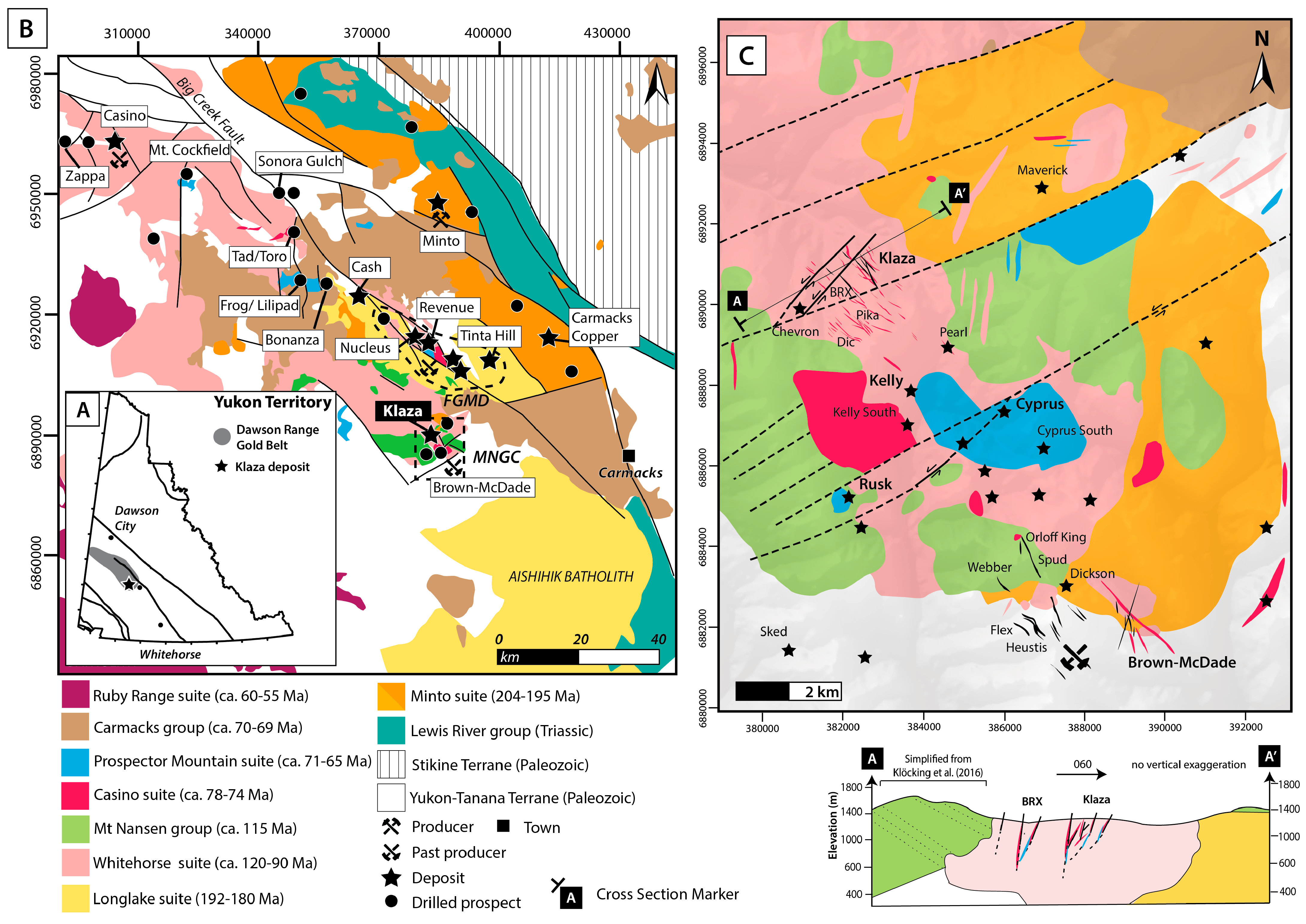
2.2. Magmatic–Hydrothermal Paragenesis and Alteration
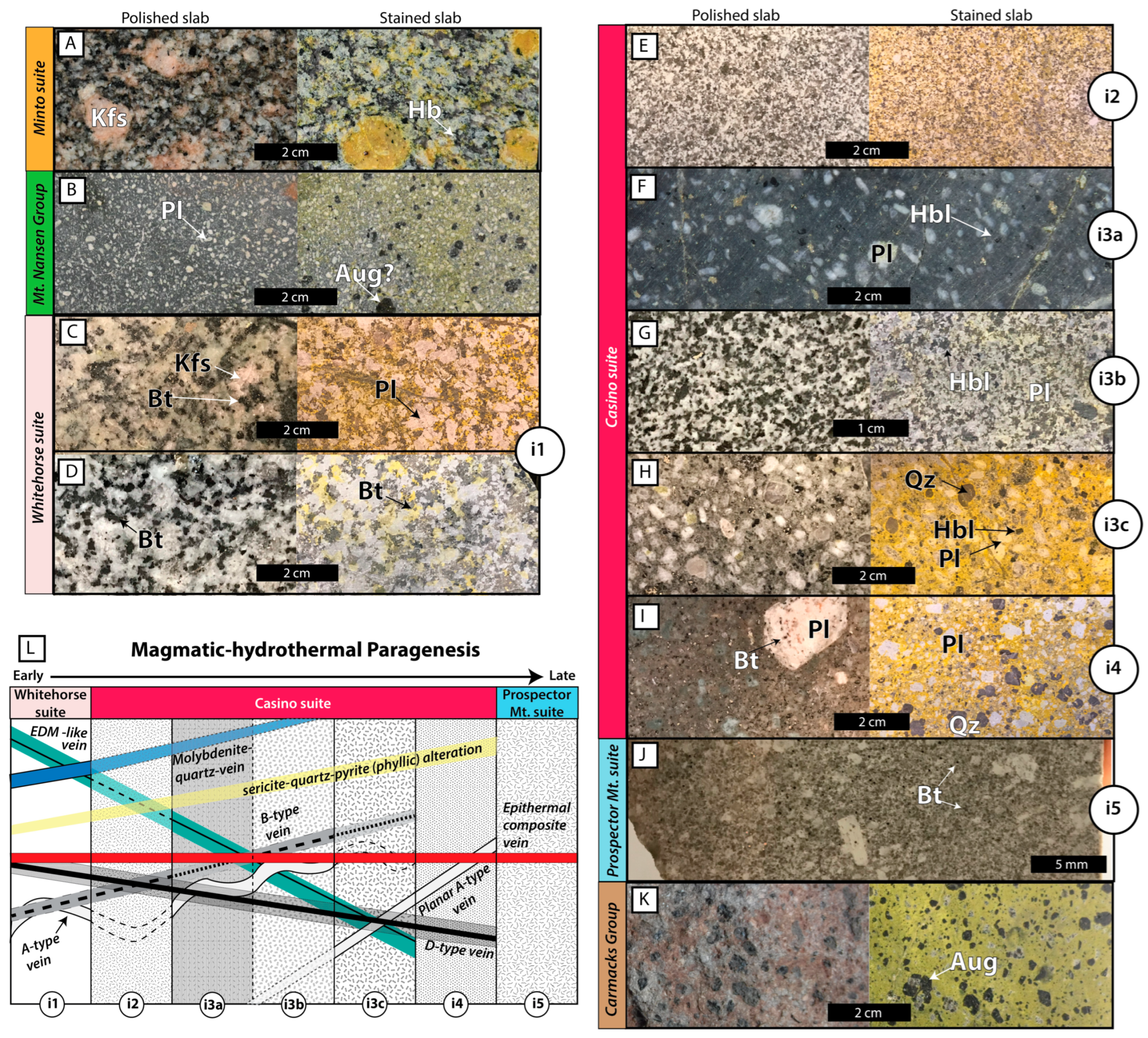

3. Methodology
3.1. Field Work and Paragenesis
3.2. Geochronology
3.3. Zircon Trace Element Analysis
4. Results
4.1. 40Ar/39Ar Muscovite Geochronology
4.2. Re–Os Molybdenite Geochronology
4.3. U–Pb Geochronology
4.4. Zircon Trace Element Geochemistry
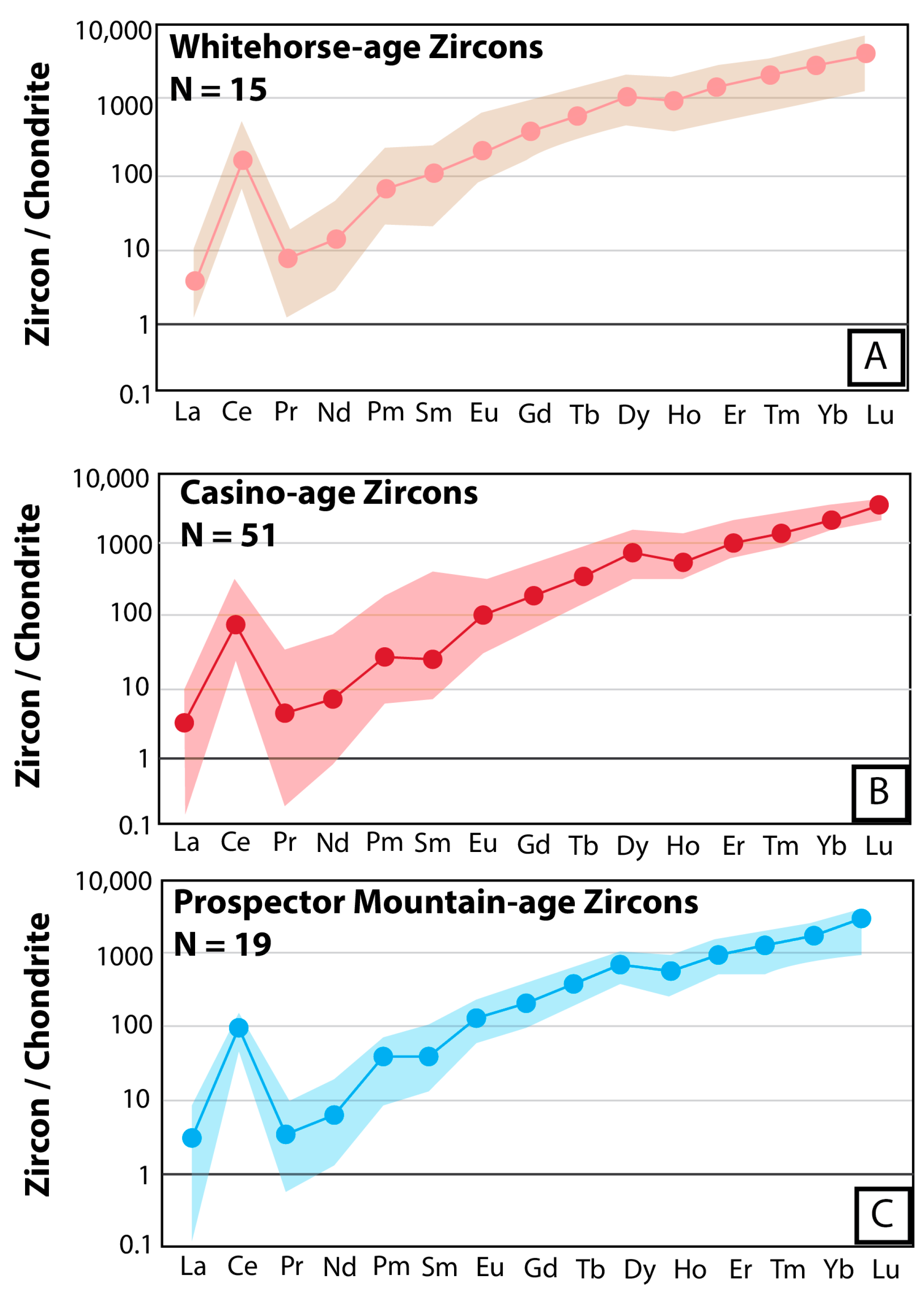

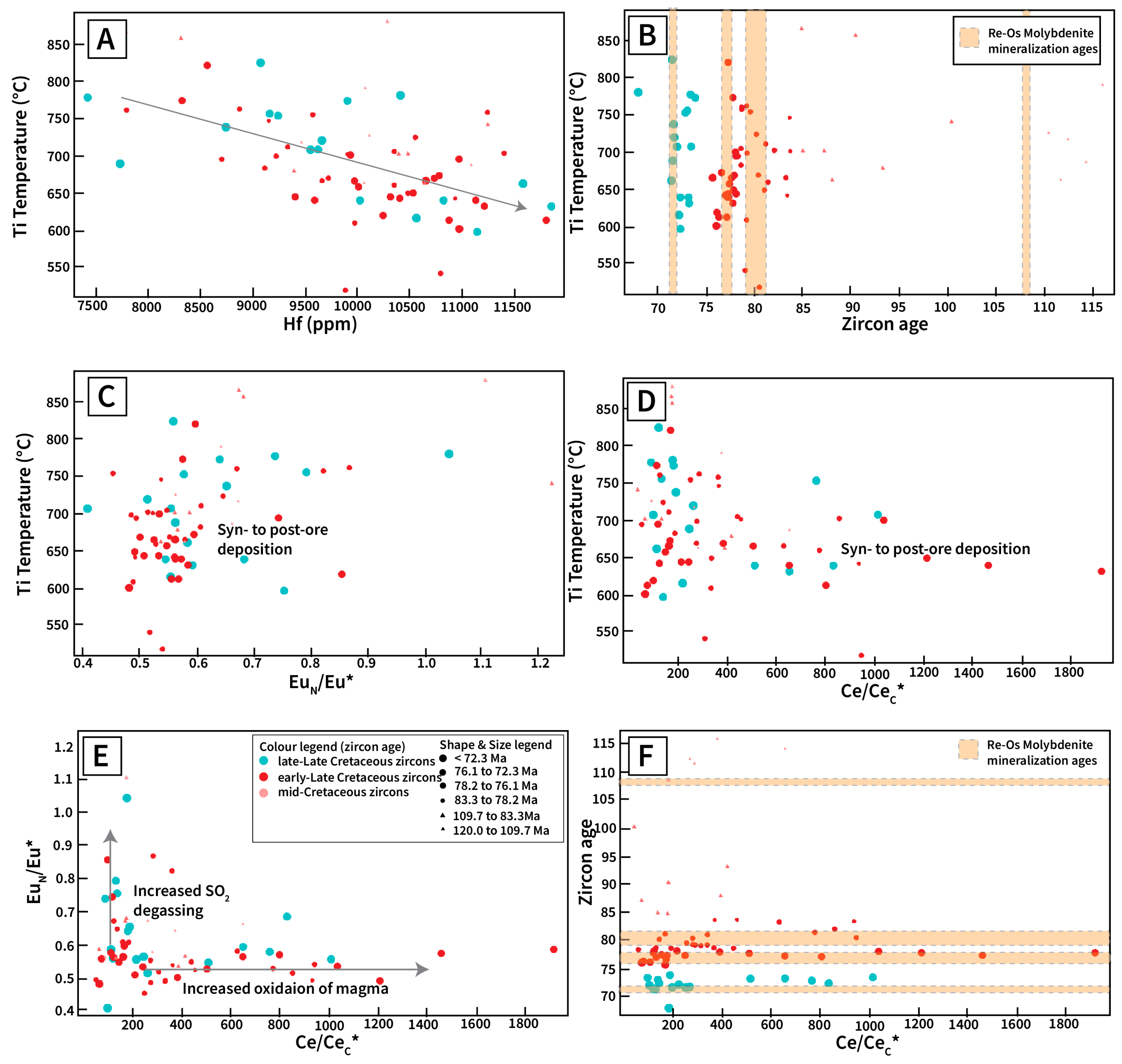
5. Discussion
5.1. Three Superimposed Magmatic–Hydrothermal Systems
5.2. Petrogenesis of the Klaza Igneous Complex
5.3. Assembly of the Klaza Igneous Complex and Superimposed Porphyry System
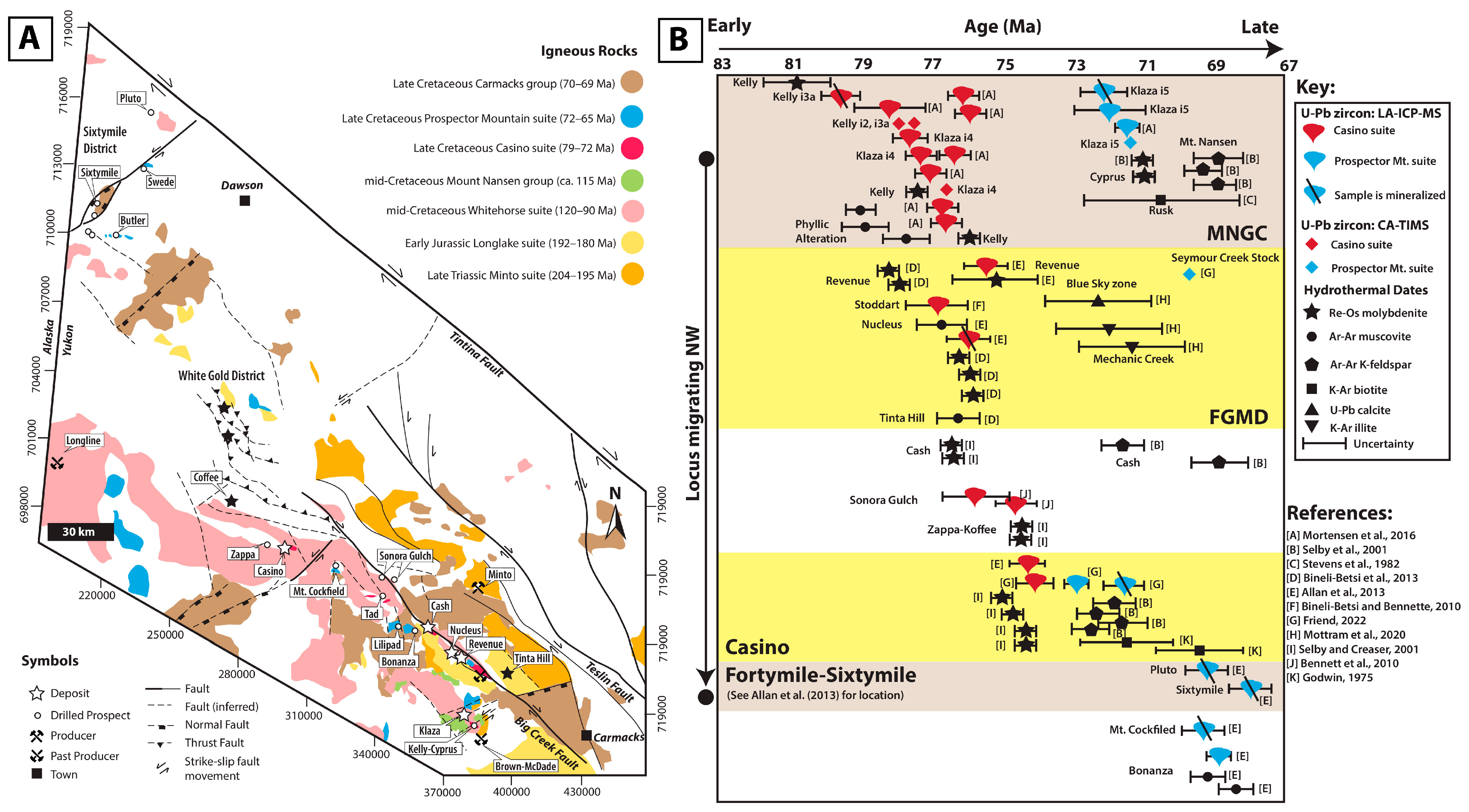
6. Exploration Implications
- (1)
- The high-precision ages assigned to each intrusive phase (Figure 8) match the paragenetic order prescribed to each phase (i2 to i5), demonstrating that a consistent, paragenetically relevant logging scheme can be built for the Klaza deposit, which will likely improve grade-control models in the future.
- (2)
- Complexities in the petrogenesis of the Casino and Prospector Mt. suite rocks have resulted in unequal distributions of zircon populations and produced a geochronologic record biased towards Casino (80–72 Ma) suite ages (Figure 14).
- (3)
- (4)
- (5)
- Current regional maps do not document the presence of the Carmacks Group basalts near localities where Prospector Mt.-age alteration is recorded (Figure 1B). Thermochronological studies [100,101] also demonstrate that it is highly unlikely that the Carmacks Group basalts underwent significant erosion since their emplacement at 70 Ma.
- (6)
- Geochronology data from other porphyry occurrences in the DRGB (Figure 17B) suggests: (i) regional magmatism in the DRGB occurs nearly continuously between 80 and 67 Ma; (ii) the boundary between Casino and Prospector Mt. suite rocks cannot be easily distinguished on the basis of geochronology alone; (iii) the locus of Casino suite magmatism and hydrothermal mineralization appears to migrate along the Big Creek Fault from the MNGC in the SE towards the Casino deposit in the NW; and (iv) the transition into Prospector Mt. suite magmatism occurs at the Casino deposit, and then proceeds further NW into the Sixtymile district and Fortymile district (Pluto), prior to being emplaced as isolated plugs in the MNGC, the FGMD, at Mt. Cockfield, and at Bonanza. Mineralization and magmatism correlated with the Prospector Mt. suite is also documented in eastern Alaska [1,102].
- (7)
- The new geochronological results presented in this study and Lee et al. [25] enable the temporal window for PCD prospectivity in the DRGB to be extended by 7 myr, encompassing Prospector Mt. suite rocks, currently identified to be sourced from environments conducive for forming PCDs.
- (8)
- Geochronological data combined with whole rock and zircon geochemical results also indicate strong similarities between the Casino and Prospector Mt. suites, with hybridized signatures varied by temporal factors. The results from this study suggest that these suites may be one-and-the-same, with the youngest a slightly evolved counterpart of the same magma source.
- (9)
- The geochronological data from the DRGB, when viewed together from a regional perspective (Figure 17), depicts a large (~200 km-long), protracted magmatic–hydrothermal event stretching from the town of Carmacks (Yukon) into eastern Alaska. This long-lived magmatic–hydrothermal system produced oxidized, hydrous magmas, and is strongly correlated with regional, orogen-parallel, transcrustal strike–slip structures (Big Creek Fault), hence containing significant tectonomagmatic building blocks [75] required to form porphyry Cu–Au districts.
- (10)
- The scale of this Late Cretaceous porphyry activity in the DRGB (~200 km-long) is comparable to the metallogenic belt of northern Chile. When overlain, the DRGB would encompass the Escondida district [103], Chuquicamata-El Abra [104], and Quebrada Blanca (note also that Late Cretaceous magmatism and mineralization also extends ~600 km further south into British Columbia and northeast into Alaska). Therefore, it is important for regional explorers to adopt a belt-scale approach to exploration in the DRGB as a metallogenic corridor.
- (11)
- Findings from this study can be further applied to other porphyry-productive metallogenic districts globally (e.g., Western Tethyan Belt, Turkey, Northern Luzon, Philippines, Northern Chile) in the search for superimposed hypogene ore shells.
- (12)
- Should sampling biases similar to that discussed for the DRGB be identified, previously overlooked intrusive suites can be revaluated for prospectivity, thus potentially increasing the number of prospective mineral targets in established districts.
7. Conclusions
Supplementary Materials
Author Contributions
Funding
Data Availability Statement
Acknowledgments
Conflicts of Interest
References
- Allan, M.M.; Mortensen, J.K.; Hart, C.J.; Bailey, L.A.; Sánchez, M.G.; Ciolkiewicz, W.; McKenzie, G.G.; Creaser, R.A. Magmatic and metallogenic framework of west-central Yukon and eastern Alaska. In Tectonics, Metallogeny, and Discovery: The North American Cordillera and Similar Accretionary Settings; Society of Economic Geologists: Littleton, CO, USA, 2013; Volume 17, pp. 111–168. [Google Scholar]
- Nelson, J.L.; Colpron, M.; Israel, S. Tectonics and Metallogeny of the Northern Cordillera of British Columbia, Yukon and Alaska. In Tectonics, Metallogeny, and Discovery: The North American Cordillera and Similar Accretionary Settings; Society of Economic Geologists: Littleton, CO, USA, 2013; Volume 17, pp. 53–110. [Google Scholar]
- Colpron, M.; Crowley, J.L.; Gehrels, G.; Long, D.G.F.; Murphy, D.C.; Beranek, L.; Bickerton, L. Birth of the northern Cordilleran orogen, as recorded by detrital zircons in Jurassic synorogenic strata and regional exhumation in Yukon. Lithosphere 2015, 7, 541–562. [Google Scholar] [CrossRef]
- Corriveau, L. Iron oxide copper-gold deposits: A Canadian perspective. In Mineral Deposits of Canada: A Synthesis of Major Deposit-types, District Metallogeny, the Evolution of Geological Provinces, and Exploration Methods; Geological Association of Canada, Mineral Deposits Division, Special Publication: St. Johns, NL, Canada, 2007; Volume 5, pp. 307–328. [Google Scholar]
- Dubé, B.; Gosselin, P.; Mercier-Langevin, P.; Hannington, M.; Galley, A. Gold-rich volcanogenic massive sulphide deposits. In Mineral Deposits of Canada: A Synthesis of Major Deposit-Types, District Metallogeny, the Evolution of Geological Provinces, and Exploration Methods; Geological Association of Canada, Mineral Deposits Division, Special Publication: St. Johns, NL, Canada, 2007; Volume 5, pp. 75–94. [Google Scholar]
- Galley, A.G.; Hannington, M.; Jonasson, I. Volcanogenic massive sulfide deposits. In Mineral Deposits of Canada: A Synthesis of Major Deposit-Types, District Metallogeny, the Evolution of Geological Provinces, and Exploration Methods; Geological Association of Canada, Mineral Deposits Division, Special Publication: St. Johns, NL, Canada, 2007; Volume 5, pp. 141–161. [Google Scholar]
- Goodfellow, W.D.; Lydon, J.W. Sedimentary-exhalative (SEDEX) deposits. In Mineral Deposits of Canada: A Synthesis of Major Deposit-Types, District Metallogeny, the Evolution of Geological Provinces, and Exploration Methods; Geological Association of Canada, Mineral Deposits Division, Special Publication: St. Johns, NL, Canada, 2007; Volume 5, pp. 163–183. [Google Scholar]
- Hart, C.J.R. Reduced intrusion-related gold systems. In Mineral Deposits of Canada: A Synthesis of Major Deposit-Types, District Metallogeny, the Evolution of Geological Provinces, and Exploration Methods; Geological Association of Canada, Mineral Deposits Division, Special Publication: St. Johns, NL, Canada, 2007; Volume 5, pp. 95–112. [Google Scholar]
- Paradis, S.; Hannigan, P.; Dewing, K. Mississippi Valley-type lead-zinc deposits. In Mineral Deposits of Canada: A Synthesis of Major Deposit-Types, District Metallogeny, the Evolution of Geological Provinces, and Exploration Methods; Geological Association of Canada, Mineral Deposits Division, Special Publication: St. Johns, NL, Canada, 2007; Volume 5, pp. 185–203. [Google Scholar]
- Peter, J.M.; Layton-Matthews, D.; Piercey, S.; Bradshaw, G.; Paradis, S.; Boulton, A. Volcanic-hosted massive sulphide deposits of the Finlayson Lake District, Yukon. In Mineral Deposits of Canada: A Synthesis of Major Deposit-Types, District Metallogeny, the Evolution of Geological Provinces, and Exploration Methods; Geological Association of Canada, Mineral Deposits Division, Special Publication: St. Johns, NL, Canada, 2007; Volume 5, pp. 471–508. [Google Scholar]
- Sinclair, W.D. Porphyry Deposits. In Mineral Deposits of Canada: A Synthesis of Major Deposit-Types, District Metallogeny, the Evolution of Geological Provinces, and Exploration Methods; Geological Association of Canada, Mineral Deposits Division, Special Publication: St. Johns, NL, Canada, 2007; Volume 5, pp. 223–243. [Google Scholar]
- Taylor, B.E. Epithermal gold deposits. In Mineral Deposits of Canada: A Synthesis of Major Deposit-Types, District Metallogeny, the Evolution of Geological Provinces, and Exploration Methods; Geological Association of Canada, Mineral Deposits Division, Special Publication: St. Johns, NL, Canada, 2007; Volume 5, pp. 113–139. [Google Scholar]
- Ross, A.A.; Kirchner, I.; Martin, C.J.; Dumala, M.R.; Methven, G. Technical Report Describing Updated Diamond Drilling, Metallurgical Testing and Mineral Resources on the Klaza Property, Yukon, Canada; NI-43-101 Technical Report; Rockhaven Resources Ltd.: Vancouver, BC, Canada, 2018. [Google Scholar]
- Ross, A.A.; Kirchner, I.; Martin, C.J.; Dumala, M.R.; Methven, G.; Molavi, M.; Warren, D.; Borntraeger, B. Technical Report Describing Updated Diamond Drilling, Metallurgical Testing and Mineral Resources on the Klaza Property, Yukon, Canada; NI-43-101 Technical Report; Rockhaven Resources Ltd.: Vancouver, BC, Canada, 2020; 263p. [Google Scholar]
- Lamb, J. The Geology and Mineralogy of the Brown McDade Mine. Master’s Thesis, University of British Columbia, Vancouver, BC, Canada, 1947; 65p. [Google Scholar]
- Hart, C.J.R.; Langdon, D.M. Geology and mineral deposits of the Mount Nansen camp, Yukon. In Yukon Exploration and Geology 1997; Government of Yukon: Whitehorse, YT, Canada, 1997; pp. 129–138. [Google Scholar]
- Mortensen, J.K.; Hart, C.J.R.; Tarswell, J.; Allan, M.M. U-Pb zircon age and Pb isotopic constraints on the age and origin of porphyry and epithermal vein mineralization in the eastern Dawson Range, Yukon. In Yukon Exploration Geology 2015; Yukon Geological Survey: Whitehorse, YT, Canada, 2016; pp. 165–185. [Google Scholar]
- Lee, W.-S. Metallogeny and Characterization of late Cretaceous Superimposed Porphyry Cu-Au-Mo and Epithermal Au-Ag Systems in the Dawson Range, Yukon, Canada: Case Study on the Klaza Deposit. Ph.D. Thesis, Laurentian University, Sudbury, ON, Canada, 2021; 272p. Available online: https://zone.biblio.laurentian.ca/handle/10219/3667 (accessed on 1 December 2022).
- Klepacki, D.W.; Wheeler, J.O. Stratigraphic and Structural Relations of the Milford, Kaslo and Slocan Groups, Goat Range, Lardeau and Nelson Map Areas, British Columbia; Geological Survey of Canada, Paper, 85-1A; Geological Survey of Canada: Ottawa, ON, Cananda, 1985; pp. 277–286. [Google Scholar]
- Sack, P.J.; Colpron, M.; Crowley, J.L.; Ryan, J.J.; Allan, M.M.; Beranek, L.P.; Joyce, N.L. Atlas of Late Triassic to Juras-sic plutons in the Intermontane terranes of Yukon. In Yukon Geological Survey Open File 2020-1; Yukon Geological Survey: Whitehorse, YT, Canada, 2020; 365p. [Google Scholar]
- Kovacs, N.; Allan, M.M.; Crowley, J.L.; Colpron, M.; Hart, C.J.R.; Zagorevski, A.; Creaser, R.A. Carmacks Copper Cu-Au-Ag Deposit: Mineralization and Post ore Migmatization of a Stikine Arc Porphyry Copper System in Yukon, Canada. Econ. Geol. 2020, 115, 1413–1442. [Google Scholar] [CrossRef]
- Logan, J.M.; Mihalynuk, M.G. Tectonic controls on early Mesozoic paired alkaline porphyry deposit belts (Cu-Au + Ag-Pt-Pd-Mo) within the Canadian Cordillera. Econ. Geol. 2014, 109, 827–858. [Google Scholar] [CrossRef]
- Klöcking, M.; Mills, L.; Mortensen, J.; Roots, C. Geology of mid-Cretaceous volcanic rocks at Mount Nansen, central Yukon, and their relationship to the Dawson Range batholith. In Yukon Geological Survey Open File 2016-25; Yukon Geological Survey: Whitehorse, YT, Canada, 2016; 37p. [Google Scholar]
- Sim, R.C.; Davis, B. Freegold Mt. Project; NI-43-101 Technical Report; Premium Nickel Resources Ltd.: Toronto, ON, Canada, 2020; 193p. [Google Scholar]
- Lee, W.-S.; Kontak, D.J.; Richards, J.P.; Barresi, T.; Creaser, R.A. Superimposed Porphyry systems in the Dawson Range, Yukon. In Tectonomagmatic Influences on Metallogeny and Hydrothermal Ore Deposits: A Tribute to Jeremy P. Richards; Society of Economic Geologists: Littleton, CO, USA, 2021; Volume 1, pp. 21–48. [Google Scholar]
- Mottram, C.M.; Kellett, D.A.; Barresi, T.; Chapman, G.G.; Halle, J. Tracking the porphyry-epithermal mineralization transition using U-Pb carbonate dating. Geology 2024, 52, 723–728. [Google Scholar] [CrossRef]
- Smuk, K. Metallogeny of Epithermal Gold and Base Metal Veins of the Southern Dawson Range, Yukon. Master’s Thesis, McGill University, Montreal, QC, Canada, 1998; p. 155. [Google Scholar]
- Glasmacher, U.; Freidrich, G. Volcanic-hosted epithermal gold-sulfide mineralization and associated enrichment processes, Sixtymile River area, Yukon Territory, Canada. In Yukon Geology; Government of Yukon: Whitehorse, YT, Canada, 1992; Volume 3, pp. 271–291. [Google Scholar]
- Johnston, S.T.; Wynne, P.J.; Francis, D.; Hart, C.J.R.; Enkin, R.J.; Engebretson, D.C. Yellowstone in Yukon: The Late Cretaceous Carmacks Group. Geology 1996, 24, 997–1000. [Google Scholar] [CrossRef]
- Mortensen, J.K.; Hart, C.J.R. Late and postaccretionary Mesozoic magmatism and metallogeny in the northern Cordillera, Yukon and east-central Alaska. In Geological Society of America Abstracts with Program; The Geological Society of America: Boulder, CO, USA, 2010; Volume 42, p. 676. [Google Scholar]
- Ciolkiewicz, W.; Mortensen, J.; Ryan, J.; Hart, C. Space-time composition patterns of the Late Cretaceous magmatism in west-central Yukon and east-central Alaska: Insights into the tectonic evolution of the northern Cordillera. In Proceedings of the Cordilleran Tectonics Workshop, Victoria, BC, Canada, 24–26 February 2012; Schedule and Abstracts. p. 15. [Google Scholar]
- Mottram, C.M.; Kellett, D.A.; Barresi, T.; Zwingmann, H.; Friend, M.; Todd, A.; Percival, J.B. Syncing fault rock clocks: Direct comparison of U-Pb carbonate and K-Ar illite fault dating methods. Geology 2020, 48, 1179–1183. [Google Scholar] [CrossRef]
- Selby, D.; Creaser, R.A. Late and mid-Cretaceous mineralization in the Northern Canadian Cordillera: Constraints from Re-Os molybdenite dates. Econ. Geol. 2001, 96, 1461–1467. [Google Scholar] [CrossRef]
- Selby, D.; Nesbitt, B.E.; Creaser, R.A.; Reynolds, P.H.; Muehlenbachs, K. Evidence for a nonmagmatic component in potassic hydrothermal fluids of porphyry Cu-Au-Mo systems, Yukon, Canada. Geochim. Cosmochim. Acta 2001, 65, 571–587. [Google Scholar] [CrossRef]
- Yukon Geological Survey. Yukon Digital Bedrock Geology. Available online: http://www.geology.gov.yk.ca/update_yukon_bedrock_geology_map.html (accessed on 20 August 2019).
- Sack, P.J.; Eriks, N.; van Loon, S. Revised geological map of Mount Nansen area (NTS 115/I3 and part of 115I/2). In Yukon Geological Survey, Open File; 2 Sheets: Sheet 1 Scale 1:50 000 and Sheet 2 Scale 1:20 000; Yukon Geological Survey: Whitehorse, YT, Canada, 2022. [Google Scholar]
- Lee, W.-S.; Kontak, D.J.; Richards, J.P.; Sack, P. Updated geology and porphyry copper potential of the Klaza deposit, Mount Nansen district (Yukon MINFILE 115I 067). In Yukon Exploration and Geology 2019; Yukon Geological Survey: Whitehorse, YT, Canada, 2020; pp. 75–97. [Google Scholar]
- Seedorff, E.; Dilles, J.H.; Proffett, J.M.; Einaudi, M.T.; Zurcher, L.; Stavast, W.J.; Johnson, D.A.; Barton, M.D. Porphyry Deposits: Characteristics and Origin of Hypogene Features. In Economic Geology 100th Anniversary Volume; Society of Economic Geologists: Littleton, CO, USA, 2005; pp. 251–298. [Google Scholar]
- Sillitoe, R.H. Porphyry Copper Systems. Econ. Geol. 2010, 105, 3–41. [Google Scholar] [CrossRef]
- Whitney, D.L.; Evans, B.W. Abbreviations for names of rock-forming minerals. Am. Mineral. 2010, 95, 185–187. [Google Scholar] [CrossRef]
- Monecke, T.; Monecke, J.; Reynolds, T.J. The influence of CO2 on the solubility of quartz in single-phase hydrothermal fluids: Implications for the formation of stockwork veins in porphyry copper deposits. Econ. Geol. 2019, 114, 1195–1206. [Google Scholar] [CrossRef]
- Lee, W.-S.; Kontak, D.J.; Petts, D.C.; Jackson, S.E. Mineral chemistry-driven protocol to unravel the complex paragenesis of the Klaza (Yukon, Canada) superimposed porphyry epithermal system. Ore Geol. Rev. 2022, 143, 27. [Google Scholar] [CrossRef]
- Moncada, D.; Mutchler, S.; Neito, A.; Reynolds, T.J.; Rimstidt, J.D.; Bodnar, R.J. Mineral textures and fluid inclusion petrography of the epithermal Ag–Au deposits at Guanajuato, Mexico: Application to exploration. J. Geochem. Explor. 2012, 114, 20–35. [Google Scholar] [CrossRef]
- Hitzman, M.W. Routine staining of drill core to determine carbonate mineralogy and distinguish carbonate alteration textures. Miner. Depos. 1999, 39, 794–798. [Google Scholar] [CrossRef]
- Zamora-Vega, O.; Richards, J.P.; Spell, T.; Dufrane, S.A.; Williamson, J. Multiple mineralization events in the Zacatecas Ag-Pb-Zn-Cu-Au district, and their relationship to the tectonomagmatic evolution of the Mesa Central, Mexico. Ore Ge-Ology Rev. 2018, 102, 519–561. [Google Scholar] [CrossRef]
- Selby, D.; Creaser, R.A. Macroscale NTIMS and microscale LA-MC-ICP-MS Re-Os isotopic analysis of molybdenite: Testing spatial restrictions for reliable Re-Os age determinations, and implications for the decoupling of Re and Os within molybdenite. Geochim. Cosmochim. Acta 2004, 68, 3897–3908. [Google Scholar] [CrossRef]
- Mattinson, J.M. Zircon U-Pb chemical abrasion (“CA-TIMS”) method: Combined annealing and multi-step partial dis-solution analysis for improved precision and accuracy of zircon ages. Chem. Geol. 2005, 220, 47–66. [Google Scholar] [CrossRef]
- Simonetti, A.; Heaman, L.M.; Chacko, T.; Banerjee, N.R. In situ petrographic thin section U-Pb dating of zircon, monazite, and titanite using laser ablation-MC-ICP-MS. Int. J. Mass Spectrom. 2006, 253, 87–97. [Google Scholar] [CrossRef]
- Patton, C.; Woodhead, J.D.; Hellstrom, J.C.; Hergt, J.M.; Greig, A.; Mass, R. Improved laser ablation U-Pb zircon geochronology through robust downhole fractionation correction. Geochem. Geophys. Geosyst. 2010, 11, 36. [Google Scholar] [CrossRef]
- Patton, C.; Hellstrom, J.; Paul, B.; Woodhead, J.; Hergt, J. Iolite: Freeware for the visualisation and processing of mass spectrometric data. J. Anal. At. Spectrom. 2011, 26, 2508–2518. [Google Scholar] [CrossRef]
- Fleck, R.J.; Sutter, J.F.; Elliot, D.H. Interpretation of discordant 40Ar/39Ar age spectra of mesozoic tholeiites from antarctica. Geochim. Cosmochim. Acta 1977, 41, 15–32. [Google Scholar] [CrossRef]
- Bellousova, E.A.; Griffin, W.L.; O’Reilly, S.Y. Zircon Crystal Morphology, Trace Element Signatures and Hf Isotope Composition as a Tool for Petrogenetic Modelling: Examples From Eastern Australian Granitoids. J. Petrol. 2006, 47, 329–353. [Google Scholar] [CrossRef]
- Corfu, F.; Hanchar, J.H.; Hoskin, P.W.O.; Kinny, P. Atlas of Zircon Textures. Rev. Mineral. Geochem. 2003, 53, 469–500. [Google Scholar] [CrossRef]
- Lu, Y.; Loucks, R.R.; Fiorentini, M. Zircon compositions as a pathfinder for porphyry Cu ± Mo ± Au deposits. In Tectonics and Metallogeny of the Tethyan Orogenic Belt; Economic Geology Special Publication 19; Society of Economic Geologists: Littleton, CO, USA, 2016; pp. 329–347. [Google Scholar]
- Watson, E.B.; Wark, D.A.; Thomas, J.B. Crystallization thermometers for zircon and rutile. Contrib. Mineral. Petrol. 2006, 151, 413–433. [Google Scholar] [CrossRef]
- Wooden, J.L.; Mazdab, F.K.; Barth, A.P. Temperatures (Ti) and compositional characteristics of zircon: Early observations using high mass resolution on the USGS Stanford SHRIMP-RG. Geochim. Cosmochim. Acta 2006, 70, 707. [Google Scholar] [CrossRef]
- Clairborne, L.L.; Miller, C.F.; Wooden, J.L. Trace element composition of igneous zircon: A thermal and compositional record of the accumulation and evolution of a large silicic batholith, Spirit Mt., Nevada. Contrib. Mineral. Petrol. 2010, 160, 511–531. [Google Scholar] [CrossRef]
- Clairborne, L.L.; Miller, C.F.; Walker, B.A. Tracking magmatic processes through Zr/Hf ratios in rocks and Hf and Ti zoning in zircons: An example from the Spirit Mt. batholith, Nevada batholith, Nevada. Mineral Mag. 2006, 70, 517–543. [Google Scholar]
- Gagnevin, D.; Daly, J.S.; Kronz, A. Zircon texture and chemical composition as a guide to magmatic processes and mixing in a granitic environment and coeval volcanic system. Contrib. Mineral. Petrol. 2010, 159, 579–596. [Google Scholar] [CrossRef]
- Moore, C.M.; Carmichael, I.S.E. The hydrous phase equilibria (to 3 kbar) of an andesite and basaltic andesite from west-ern Mexico: Constraints on water content and conditions of phenocryst growth. Contrib. Mineral. Petrol. 1998, 130, 304–319. [Google Scholar] [CrossRef]
- Richards, J.P.; Spell, T.; Rameh, E.; Razique, A.; Feltcher, T. High Sr/Y Magmas Reflect Arc Maturity, High Mag-matic Water Content, and Porphyry Cu ± Mo ± Au Potential: Examples from the Tethyan Arcs of Central and Eastern Iran and Western Pakistan. Econ. Geol. 2012, 107, 295–332. [Google Scholar] [CrossRef]
- Sun, W.; McDonough, W.F. Chemical and isotopic systematics of oceanic basalts: Implications for mantle composition and processes. Geol. Soc. Lond. Spec. Publ. 1989, 42, 313–345. [Google Scholar] [CrossRef]
- Tang, M.; Lee, C.A.; Chen, K.; Erdman, M.; Costin, G.; Jiang, H. Nb/Ta systematics in arc magma differentiation and the role of arclogites in continent formation. Nat. Commun. 2019, 10, 235. [Google Scholar] [CrossRef] [PubMed]
- Li, L.; Xiong, X.L.; Liu, X.C. Nb/Ta Fractionation by Amphibole in Hydrous Basaltic Systems: Implications for Arc Magma Evolution and Continental Crust Formation. J. Petrol. 2017, 58, 3–28. [Google Scholar] [CrossRef]
- Ferry, J.M.; Watson, E.B. New thermodynamic models and revised calibrations for the Ti-in-zircon and Zr-in-rutile thermometers. Contrib Mineral Petrol. 2007, 154, 429–437. [Google Scholar] [CrossRef]
- Ballard, J.R.; Palin, J.M.; Campbell, I.H. Relative oxidation states of magmas inferred from Ce“IV”/Ce“III” in zircon: Ap-plication to porphyry copper deposits of northern Chile. Contrib. Mineral. Petrol. 2002, 144, 347–364. [Google Scholar] [CrossRef]
- Shen, P.; Hattori, K.; Pan, H. Oxidation condition and metal fertility of granitic magmas: Zircon trace-element data from porphyry Cu deposits in the central Asian orogenic belt. Econ. Geol. 2015, 110, 1861–1878. [Google Scholar] [CrossRef]
- Zhong, S.; Seltmann, R.; Qu, H.; Song, Y. Characterization of the zircon Ce anomaly for estimation of oxidation state of magmas: A revised Ce/Ce* method. Mineral. Petrol. 2019, 113, 755–763. [Google Scholar] [CrossRef]
- Loader, M.A.; Wilkinson, J.J.; Armstrong, R.N. The effect of titanite crystallisation on Eu and Ce anomalies in zircon and its implications for the assessment of porphyry Cu deposit fertility. Earth Planet. Sci. Lett. 2017, 472, 107–119. [Google Scholar] [CrossRef]
- Mortensen, J.K.; Appel, V.L.; Hart, C.J.R. Geological and U-Pb age constraints on base and precious metal vein systems in the Mount Nansen area, eastern Dawson Range, Yukon. In Yukon Exploration and Geology 2002; Exploration and Geological Services Division, Yukon Region, Indian and Northern Affairs Canada: Whitehorse, YT, Canada, 2003; pp. 165–174. [Google Scholar]
- Stevens, R.D.; Delabio, R.N.; Lachance, G.R. Age Determinations and Geological Studies, K-Ar Isotopic Ages; Geological Survey of Canada, Paper 82-2; Geological Survey of Canada: Ottawa, ON, Cananda, 1982; 52p. [Google Scholar]
- Lund, K.; Aleinikoff, J.N.; Kunk, M.J.; Unruh, D.M.; Zeihen, G.D.; Hodges, W.C.; Du Bray, E.A.; O’Neill, J.M. SHRIMP U-Pb and 40Ar/39Ar Age Constraints for Relating Plutonism and Mineralization in the Boulder Batholith Region, Montana. Econ. Geol. 2002, 97, 241–267. [Google Scholar] [CrossRef]
- Richards, J.P. High Sr/Y Arc Magmas and Porphyry Cu ± Mo ± Au Deposits: Just Add Water. Econ. Geol. 2011, 106, 1075–1081. [Google Scholar] [CrossRef]
- Correa, K.J.; Rabbia, O.M.; Hernandez, L.B.; Selby, D.; Astengio, M. The Timing of Magmatism and Ore Formation in the El Abra Porphyry Copper Deposit, Northern Chile: Implications for Long-Lived Multiple-Event Magmatic-Hydrothermal Porphyry Systems. Econ. Geol. 2016, 111, 1–28. [Google Scholar] [CrossRef]
- Richards, J.P. Tectono-Magmatic Precursors for Porphyry Cu-(Mo-Au) Deposit Formation. Econ. Geol. 2003, 98, 1515–1533. [Google Scholar] [CrossRef]
- Harrison, M.T.; Watson, B.E.; Aikman, A.B. Temperature spectra of zircon crystallization in plutonic rocks. Geology 2007, 35, 635–638. [Google Scholar] [CrossRef]
- Tapster, S.; Condon, D.J.; Naden, J.; Noble, S.R.; Petterson, M.G.; Roberts, N.M.W.; Saunders, A.D.; Smith, D.J. Rap-id thermal rejuvenation of high-crystallinity magma linked to porphyry copper deposit formation; evidence from the Koloula Porphyry Prospect, Solomon Islands. Earth Planet. Sci. Lett. 2016, 442, 206–217. [Google Scholar] [CrossRef]
- Dilles, J.H.; Kent, A.J.R.; Wooden, J.L. Zircon compositional evidence for sulfur degassing from ore-forming arc magmas. Econ. Geol. 2015, 110, 241–251. [Google Scholar] [CrossRef]
- Lee, R.G.; Byrne, K.; D’Angelo, M.; Hart, C.J.R.; Hollings, P.; Gleeson, S.A.; Alfaro, M. Using zircon trace element composition to assess porphyry copper potential of the Guichon Creek batholith and Highland Valley Copper deposit, south-central British Columbia. Miner. Depos. 2020, 56, 215–238. [Google Scholar] [CrossRef]
- Green, T.H.; Pearson, N.J. Experimental determination of REE partition coefficients between amphibole and basaltic to andesitic liquids at high pressure. Geochim. Cosmochim. Acta 1985, 49, 1465–1468. [Google Scholar] [CrossRef]
- Erdmann, S.; Wodicka, N.; Jackson, S.E.; Corrigan, D. Zircon textures and composition: Refractory recorders of magmatic volatile evolution? Contrib. Mineral. Petrol. 2013, 165, 45–71. [Google Scholar] [CrossRef]
- Kelley, K.D.; Ludington, S. Cripple Creek and other alkaline-related gold deposits in the southern Rocky Mountains, USA: Influence of regional tectonics. Miner. Depos. 2002, 37, 38–60. [Google Scholar] [CrossRef]
- Hollings, P.; Wolfe, R.; Cooke, D.R.; Waters, P.J. Geochemistry of Tertiary Igneous Rocks of Northern Luzon, Philippines: Evidence for a Back-Arc Setting for Alkalic Porphyry Copper-Gold Deposits and a Case for Slab Roll-Back? Econ. Geol. 2011, 106, 1257–1277. [Google Scholar] [CrossRef]
- Richards, J.P.; Lopez, G.P.; Zhu, J.-J.; Creaser, R.A.; Locock, A.J.; Mumin, A.H. Contrasting Tectonic Settings and Sulfur Contents of Magmas Associated with Cretaceous Porphyry Cu ± Mo ± Au and Intrusion-Related Iron Oxide Cu-Au De-posits in Northern Chile. Econ. Geol. 2016, 112, 295–318. [Google Scholar] [CrossRef]
- Rabayrol, F.; Hart, C.J.R.; Thorkelson, D.J. Temporal, spatial and geochemical evolution of late Cenozoic post-subduction magmatism in central and eastern Anatolia, Turkey. Lithos 2019, 336, 67–96. [Google Scholar] [CrossRef]
- Frey, F.A.; Green, D.H.; Roy, S.D. Integrated Models of Basalt Petrogenesis: A Study of Quartz Tholeiites to Olivine Melilitites from South Eastern Australia Utilizing Geochemical and Experimental Petrological Data. J. Petrol. 1978, 19, 463–513. [Google Scholar] [CrossRef]
- Richards, J.P.; Kerrich, R. Special Paper: Adakite-Like Rocks: Their Diverse Origins and Questionable Role in Metallogenesis. Econ. Geol. 2007, 102, 537–576. [Google Scholar] [CrossRef]
- Olierook, H.K.H.; Kirkland, C.L.; Szilas, K.; Hollis, J.A.; Gardiner, N.J.; Steenfelt, A.; Jiang, Q.; Yakymchuk, C.; Evans, N.J.; McDonald, B.J. Differentiating between inherited and autocrystic zircon in granitoids. J. Petrol. 2020, 61, egaa081. [Google Scholar] [CrossRef]
- Gilmer, A.K.; Sparks, R.S.J.; Blundy, J.D.; Rust, A.C.; Hauff, F.; Hoernle, K.; Spencer, C.J.; Tapster, S. Petrogenesis and Assembly of the Don Manuel Igneous Complex, Miocene–Pliocene Porphyry Copper Belt, Central Chile. J. Petrol. 2018, 59, 1067–1108. [Google Scholar] [CrossRef]
- Bickerton, L.; Kontak, D.J.; Murphy, J.B.; Kellett, D.A.; Samson, I.A.; Marsh, J.H.; Dunning, G.; Stern, R. The age and origin of the South Mountain Batholith (Nova Scotia, Canada) as constrained by zircon U–Pb geochronology, geochemistry, and O–Hf isotopes. Can. J. Earth Sci. 2022, 59, 418–454. [Google Scholar] [CrossRef]
- Monger, J.W.H.; Gibson, H.D. Mesozoic-Cenozoic deformation in the Canadian Cordillera: The record of a “Conti-nental Bulldozer”? Tectonophysics 2019, 757, 153–169. [Google Scholar] [CrossRef]
- Gabrielse, H.; Murphy, D.C.; Mortensen, J.K. Cretaceous and Cenozoic dextral orogen-parallel displacements, magmatism, and paleogeography, north-central Canadian Cordillera. In Paleogeography of the North American Cordillera: Evidence For and Against Large-Scale Displacements; Special Paper 46; Geological Association of Canada: St. John’s, NL, Canada, 2006; pp. 255–276. [Google Scholar]
- Topham, M.J.; Allan, M.M.; Mortensen, J.K.; Hart, C.J.R.; Colpron, M.; Sack, P.J. Crustal depth of emplacement of the Early Jurassic Aishihik and Tatchun batholiths, west central Yukon. In Yukon Exploration and Geology 2015; Yukon Geological Survey: Whitehorse, YT, Canada, 2016; pp. 233–251. [Google Scholar]
- Richards, J.P. Postsubduction porphyry Cu-Au and epithermal Au deposits: Products of remelting of subduction-modified lithosphere. Geology 2009, 37, 247–250. [Google Scholar] [CrossRef]
- Bineli Betsi, T.; Lentz, D.; Chiaradia, M.; Kyser, K.; Creaser, R.A. Genesis of the Au-Bi-Cu-As, Cu-Mo ± W, and base-metal Au-Ag mineralization at the Mt. Freegold (Yukon, Canada): Constraints from Ar-Ar and Re-Os geochronology and Pb and stable isotope compositions. Miner. Depos. 2013, 48, 991–1017. [Google Scholar] [CrossRef]
- Bineli Betsi, T.; Bennett, V. New U-Pb age constraints at Freegold Mt.: Evidence for multiple phases of polymetallic mid- to Late Cretaceous mineralization. In Yukon Exploration and Geology 2009; Government of Yukon: Whitehorse, YT, Canada, 2010; pp. 57–84. [Google Scholar]
- Friend, M.A. Tectonomagmatic Framework for Late Cretaceous Post-Subduction Metallogeny in the Dawson Range, West-Central Yukon. Master’s Thesis, University of British Columbia, Vancouver, BC, Canada, 2022. [Google Scholar]
- Bennett, V.; Schulze, C.; Ouellette, D.; Pollries, B. Deconstructing complex Au-Ag Cu mineralization, Sonora Gulch project, Dawson Range: A Late Cretaceous evolution to the epithermal environment. In Yukon Exploration and Geology 2009; Government of Yukon: Whitehorse, YT, Canada, 2010; pp. 23–45. [Google Scholar]
- Godwin, C.I. Geology of the Casino Porphyry Copper-Molybdenum Deposit, Dawson Range, Y.T. Ph.D. Thesis, University of British Columbia, Vancouver, BC, Canada, 1975; 274p. [Google Scholar]
- Bineli-Betsi, T.; Lentz, D.; Mcinnes, B.; Evans, N. Emplacement ages and exhumation rates for intrusion-hosted Cu-Mo-Sb-Au mineral systems at Freegold Mt. (Yukon, Canada): Assessment from U-Pb, Ar-Ar, and (U-Th)/He geochronometers. Can. J. Earth Sci. 2012, 49, 653–670. [Google Scholar] [CrossRef]
- Moher, M. (U-Th)/He Thermochronology of the Aishihik Batholith, Central Yukon: Evidence for Stable Crust in the Cretaceous. Master’s Thesis, University of Ottawa, Ottawa, ON, Canada, 2018; 83p. [Google Scholar]
- Kreiner, D.C.; Holm-Denoma, C.; Pianowski, L.; Flood, Z.; Stevenson, D.; Graham, G.E.; Vazquez, J.; Creaser, R.A. Geochronology and Mapping Constraints on the Time-Space Evolution of the Igneous and Hydrothermal Systems in the Taurus Cu-Mo District, Eastern Alaska. Econ. Geol. 2023, 118, 745–778. [Google Scholar] [CrossRef]
- Richards, J.P.; Boyce, A.J.; Pringle, M.S. Geologic Evolution of the Escondida Area, Northern Chile: A Model for Spatial and Temporal Localization of Porphyry Cu Mineralization. Econ. Geol. 2001, 96, 271–305. [Google Scholar] [CrossRef]
- Campbell, I.H.; Ballard, J.R.; Palin, J.M.; Allen, C.; Faunes, A. U-Pb Zircon Geochronology of Granitic Rocks from the Chuquicamata-El Abra Porphyry Copper Belt of Northern Chile: Excimer Laser Ablation ICP-MS Analysis. Econ. Geol. 2006, 101, 1327–1344. [Google Scholar] [CrossRef]
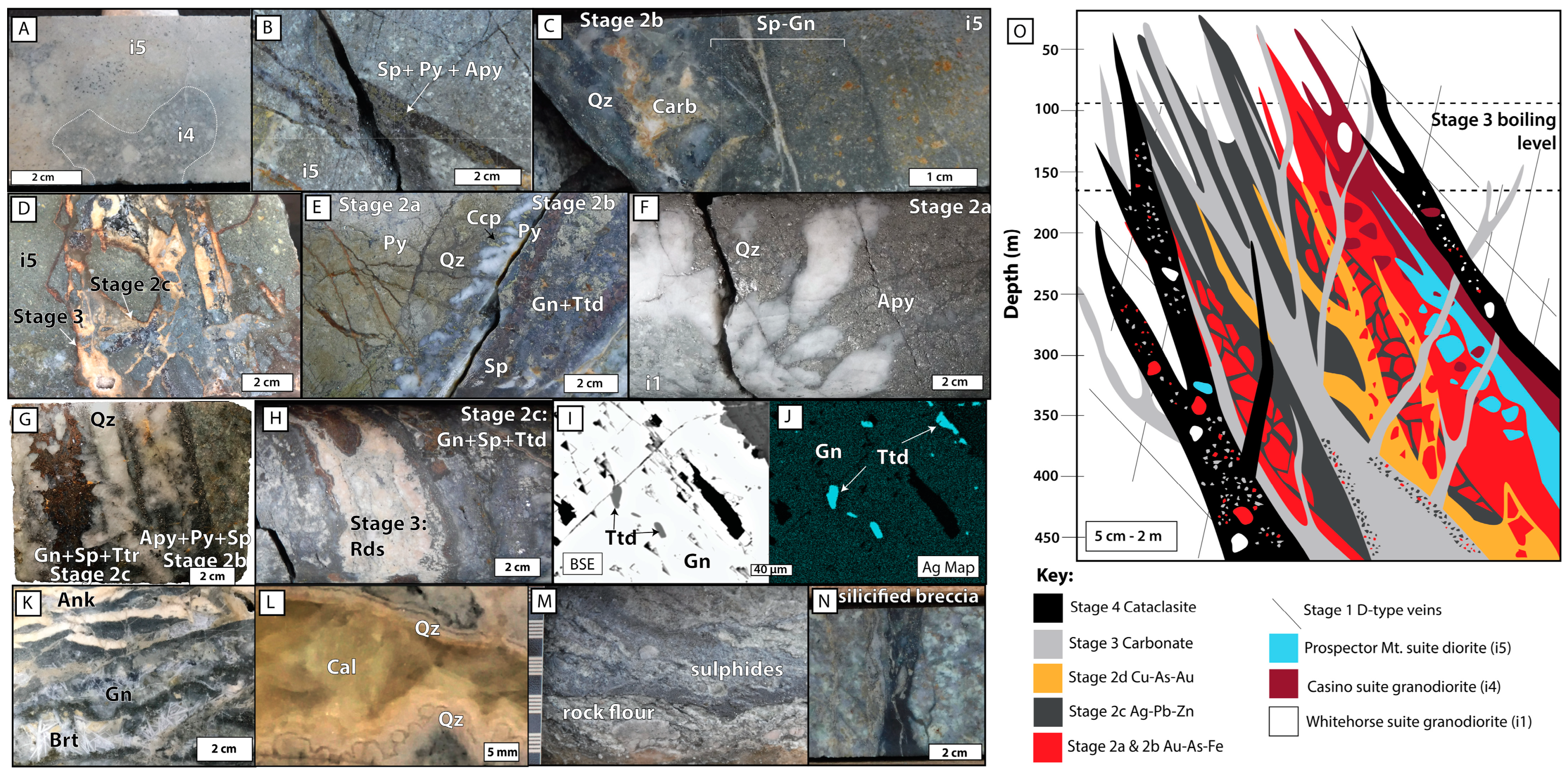
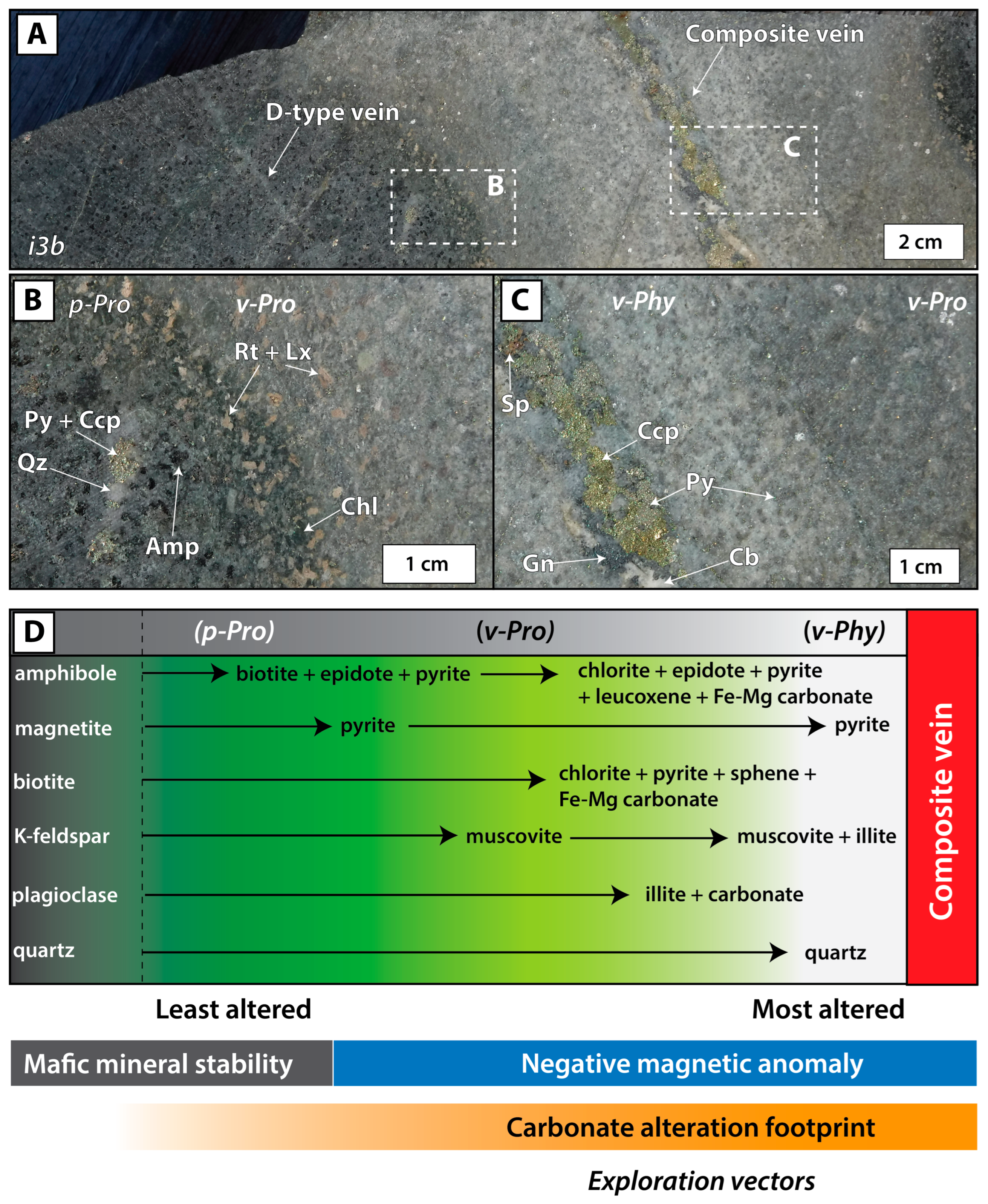
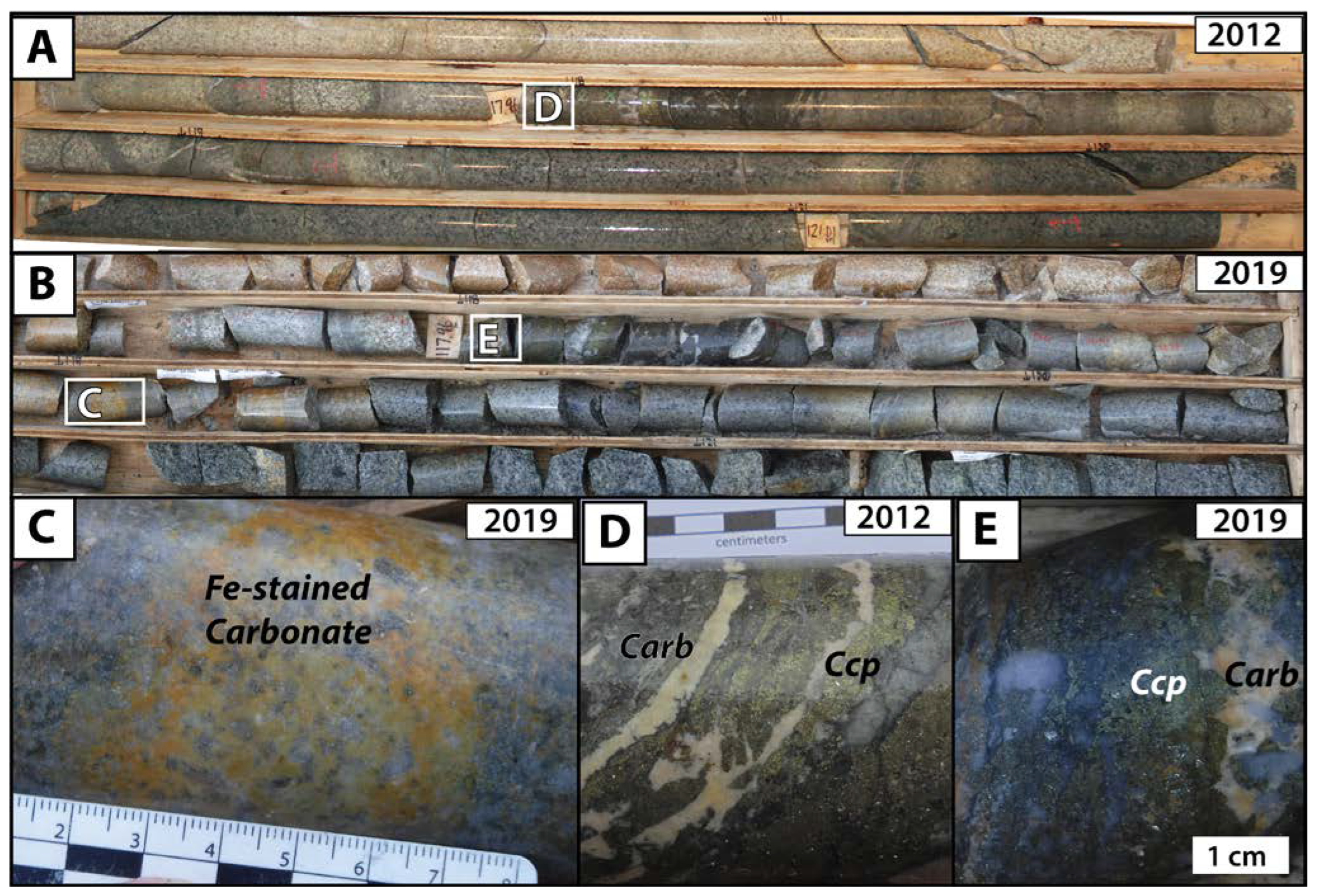
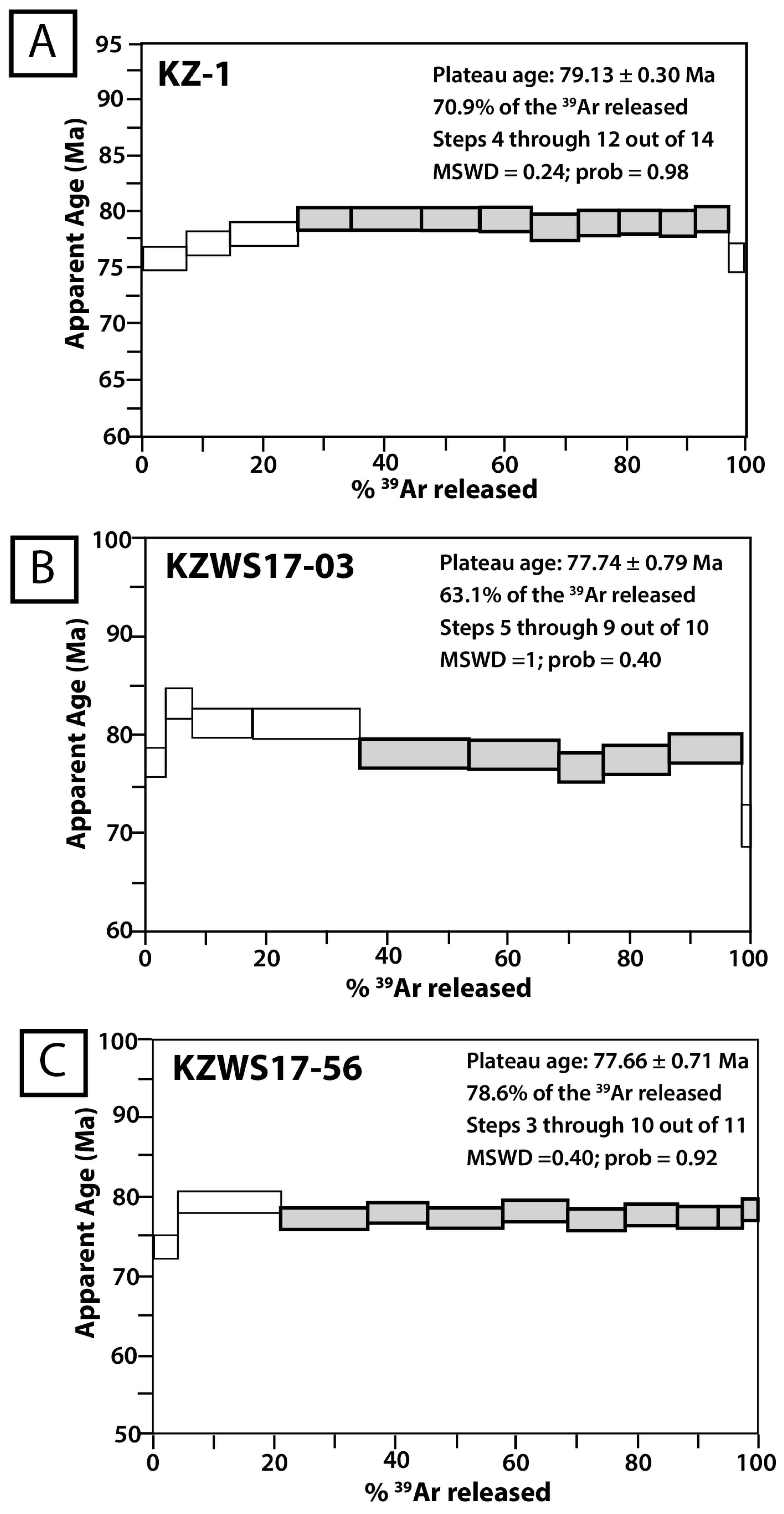

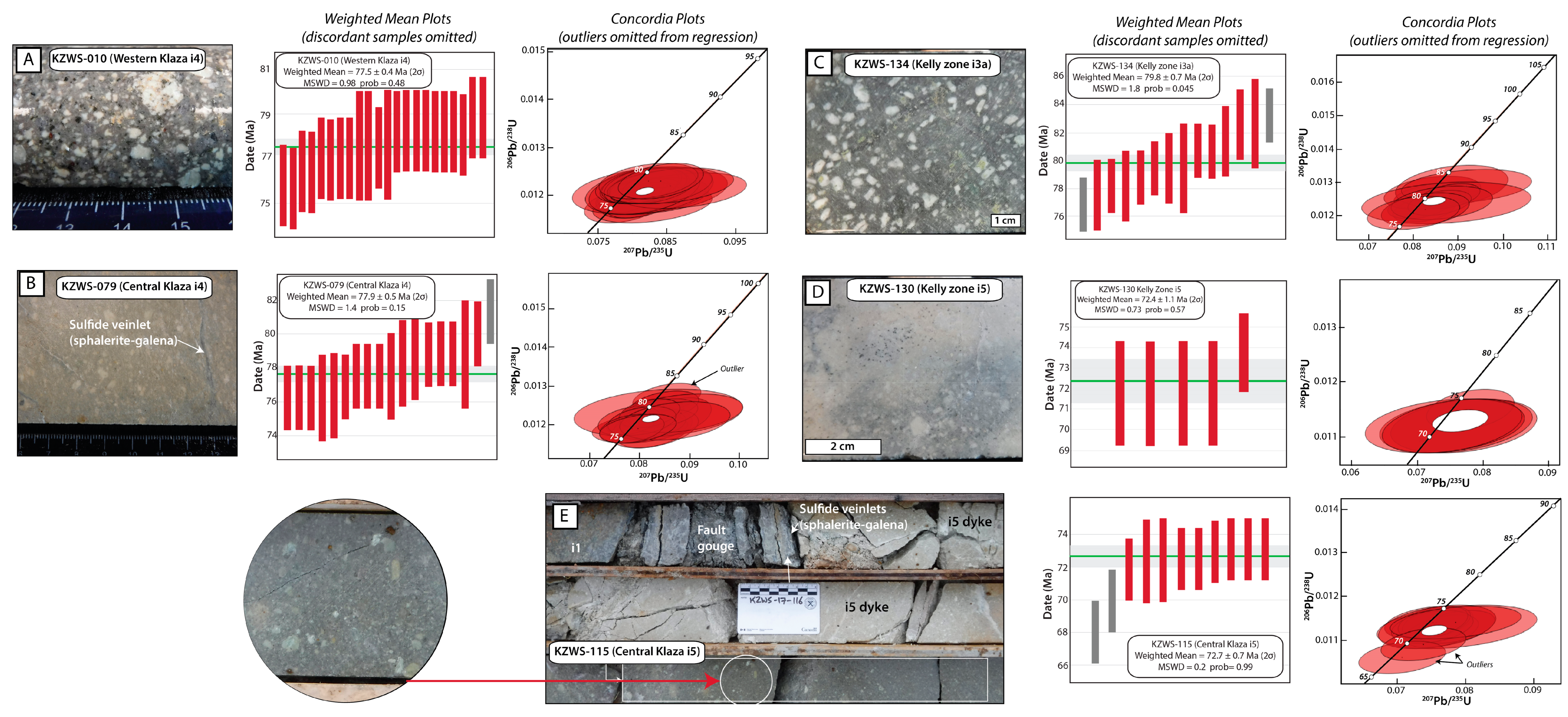
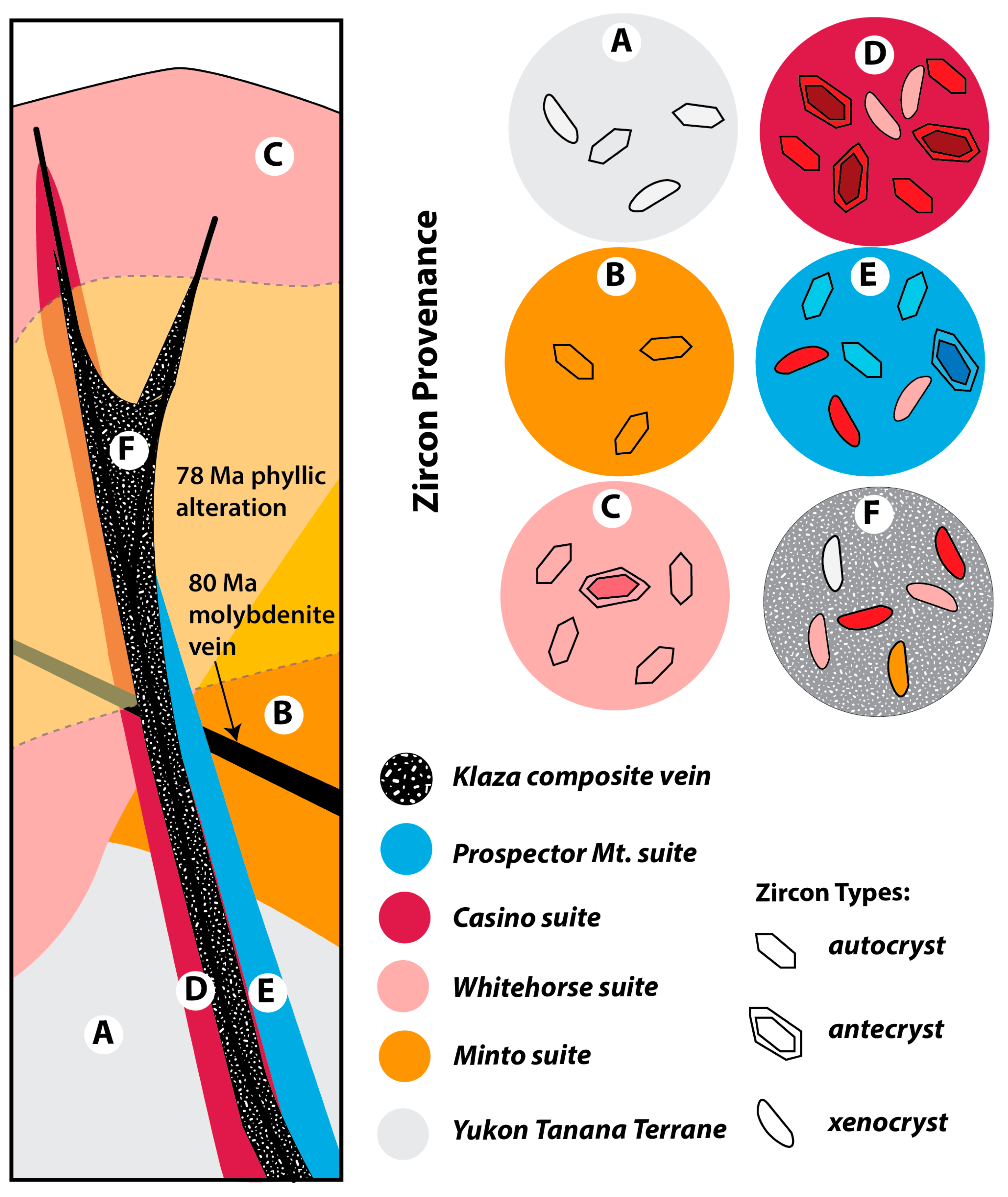

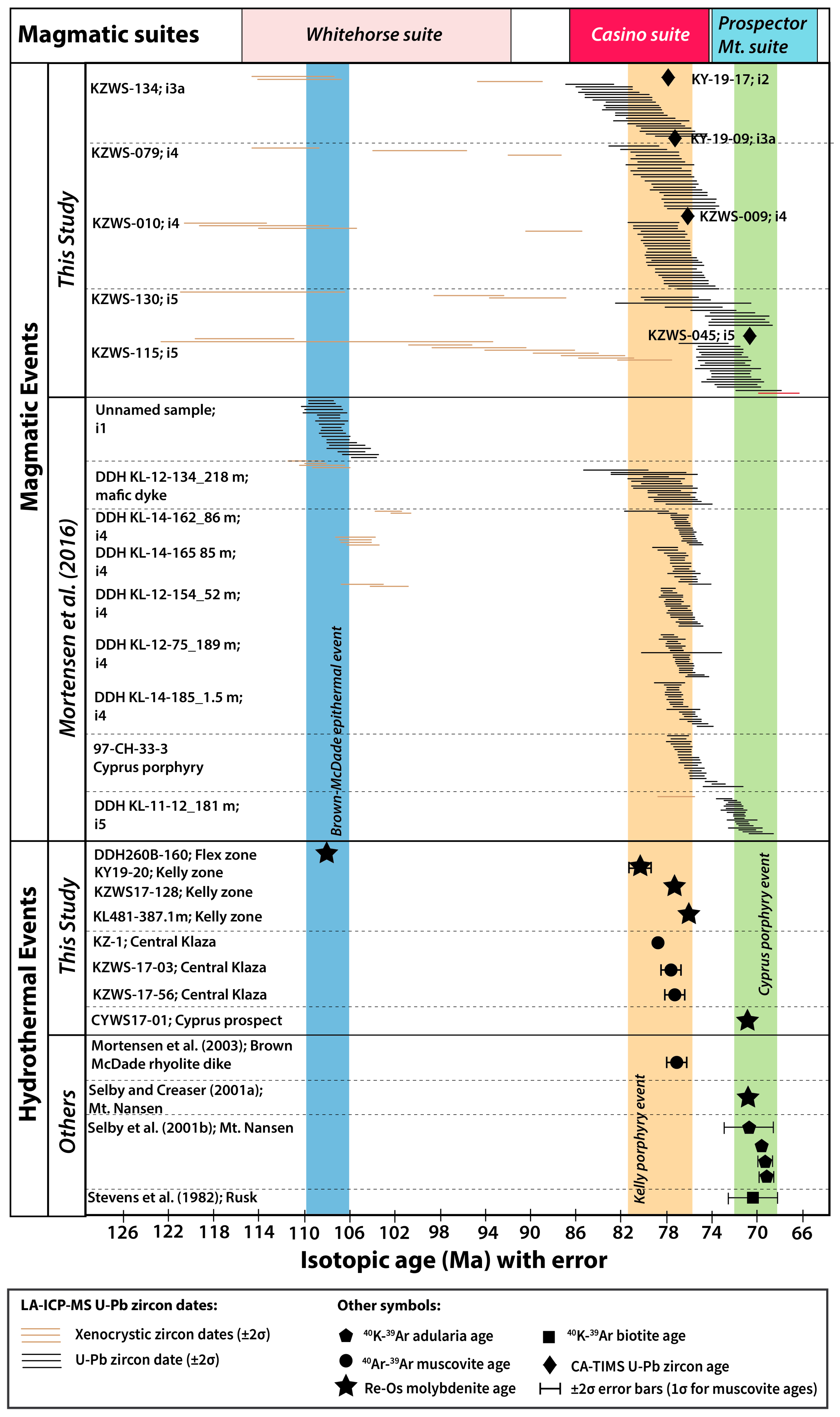
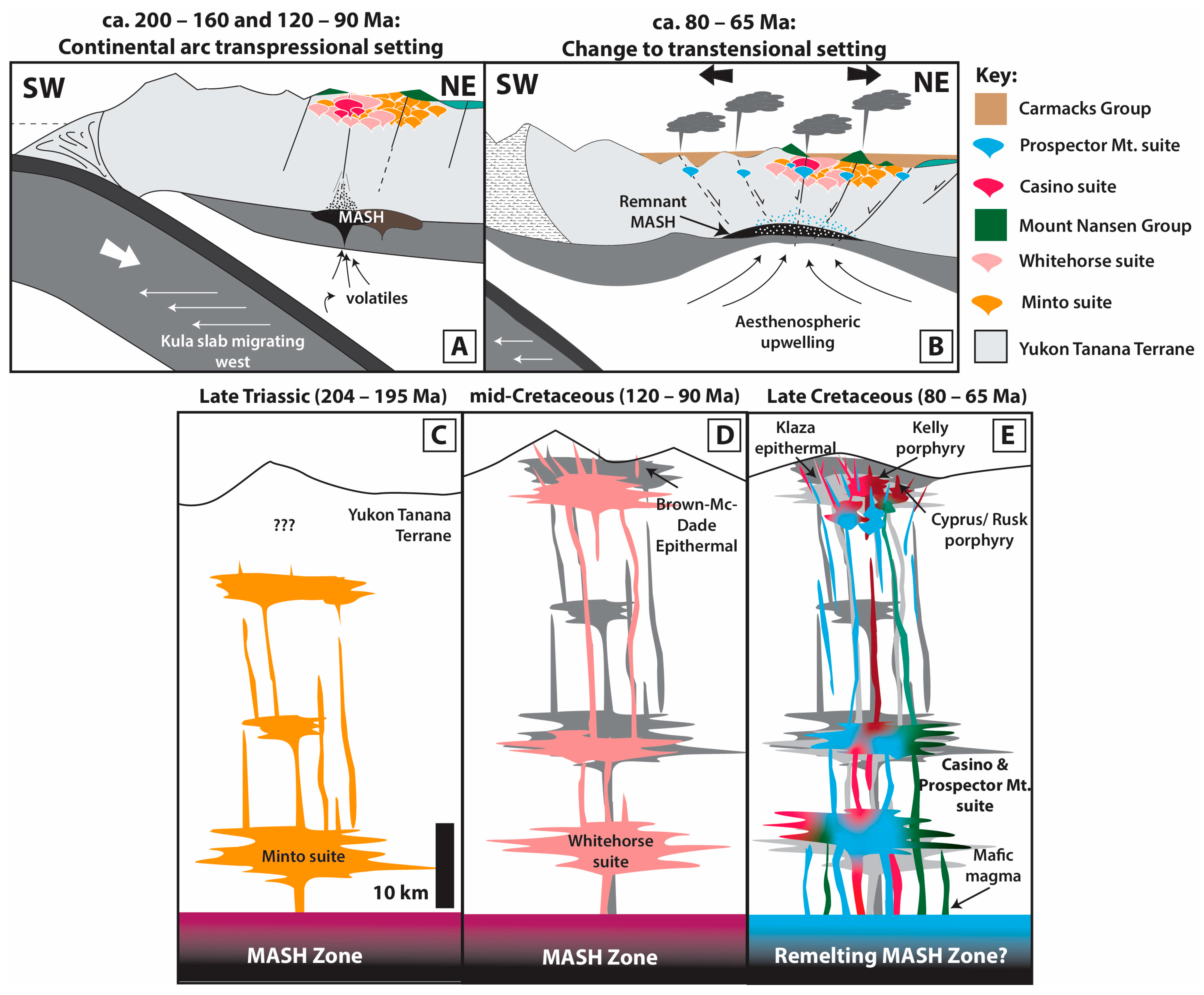
| Intrusive Phase | % Quartz | % Plagioclase | % K-Feldspar | % Biotite | % Hornblende | % Sericite * |
|---|---|---|---|---|---|---|
| i1 | 25–40 | 30–45 | 0–20 | 10–15 | 1–8 | 5–15 |
| i2 | 30 | 40 | ? | 0–1 | 0–5 | 20–30 |
| i3a | 0–5 | 30–40 | 0 | 0–5 | 5–10 | 5–10 |
| i3b | 0–5 | 45–50 | 0 | 20–25 | 30 | 5–10 |
| i3c | 25–30 | 30–40 | ? | 7–10 | 2–5 | 30–50 |
| i4 | 15–20 | 25–30 | ? | 5–10 | 0–1 | 30–50 |
| i5 | 0–5 | ? | ? | 5–10 | 0–5 | 50–65 |
| Sample ID | Re (ppm) | ±2σ | 187Re (ppm) | ±2σ | 187Os (ppb) | ±2σ | Model Age (Ma) | ±2σ (Ma) |
|---|---|---|---|---|---|---|---|---|
| DDH260B-160 FLEX | 1085 | 3 | 681.8 | 1.9 | 1233.4 | 0.3 | 108.5 | 0.5 |
| DDH260B-160 FLEX RPT 1 | 1139 | 3 | 715.6 | 2.0 | 1302.1 | 0.1 | 109.1 | 0.5 |
| DDH260B-160 FLEX-MAG 2 | 35.08 | 0.10 | 22.05 | 0.06 | 40.19 | 0.08 | 109.3 | 0.5 |
| KL481-387.1m | 6.452 | 0.018 | 4.056 | 0.011 | 5.161 | 0.014 | 76.3 | 0.4 |
Disclaimer/Publisher’s Note: The statements, opinions and data contained in all publications are solely those of the individual author(s) and contributor(s) and not of MDPI and/or the editor(s). MDPI and/or the editor(s) disclaim responsibility for any injury to people or property resulting from any ideas, methods, instructions or products referred to in the content. |
© 2024 by the authors. Licensee MDPI, Basel, Switzerland. This article is an open access article distributed under the terms and conditions of the Creative Commons Attribution (CC BY) license (https://creativecommons.org/licenses/by/4.0/).
Share and Cite
Lee, W.-S.; Kontak, D.J.; Sack, P.J.; Crowley, J.L.; Creaser, R.A. Geology, Petrology and Geochronology of the Late Cretaceous Klaza Epithermal Deposit: A Window into the Petrogenesis of an Emerging Porphyry Belt in the Dawson Range, Yukon, Canada. Minerals 2025, 15, 38. https://doi.org/10.3390/min15010038
Lee W-S, Kontak DJ, Sack PJ, Crowley JL, Creaser RA. Geology, Petrology and Geochronology of the Late Cretaceous Klaza Epithermal Deposit: A Window into the Petrogenesis of an Emerging Porphyry Belt in the Dawson Range, Yukon, Canada. Minerals. 2025; 15(1):38. https://doi.org/10.3390/min15010038
Chicago/Turabian StyleLee, Well-Shen, Daniel J. Kontak, Patrick J. Sack, James L. Crowley, and Robert A. Creaser. 2025. "Geology, Petrology and Geochronology of the Late Cretaceous Klaza Epithermal Deposit: A Window into the Petrogenesis of an Emerging Porphyry Belt in the Dawson Range, Yukon, Canada" Minerals 15, no. 1: 38. https://doi.org/10.3390/min15010038
APA StyleLee, W.-S., Kontak, D. J., Sack, P. J., Crowley, J. L., & Creaser, R. A. (2025). Geology, Petrology and Geochronology of the Late Cretaceous Klaza Epithermal Deposit: A Window into the Petrogenesis of an Emerging Porphyry Belt in the Dawson Range, Yukon, Canada. Minerals, 15(1), 38. https://doi.org/10.3390/min15010038







